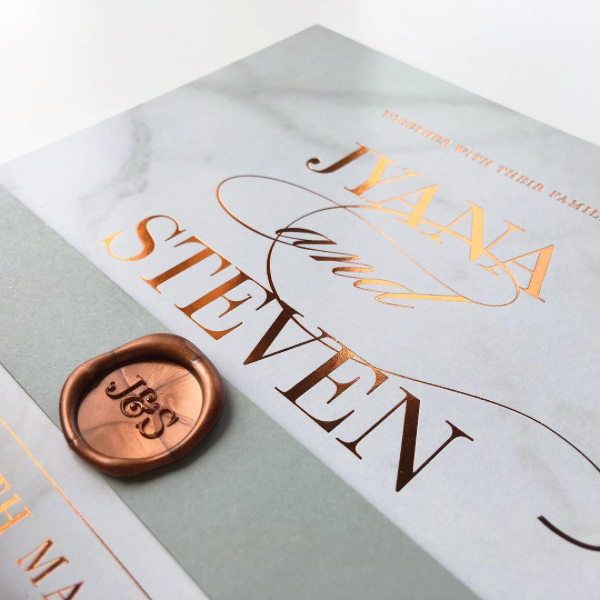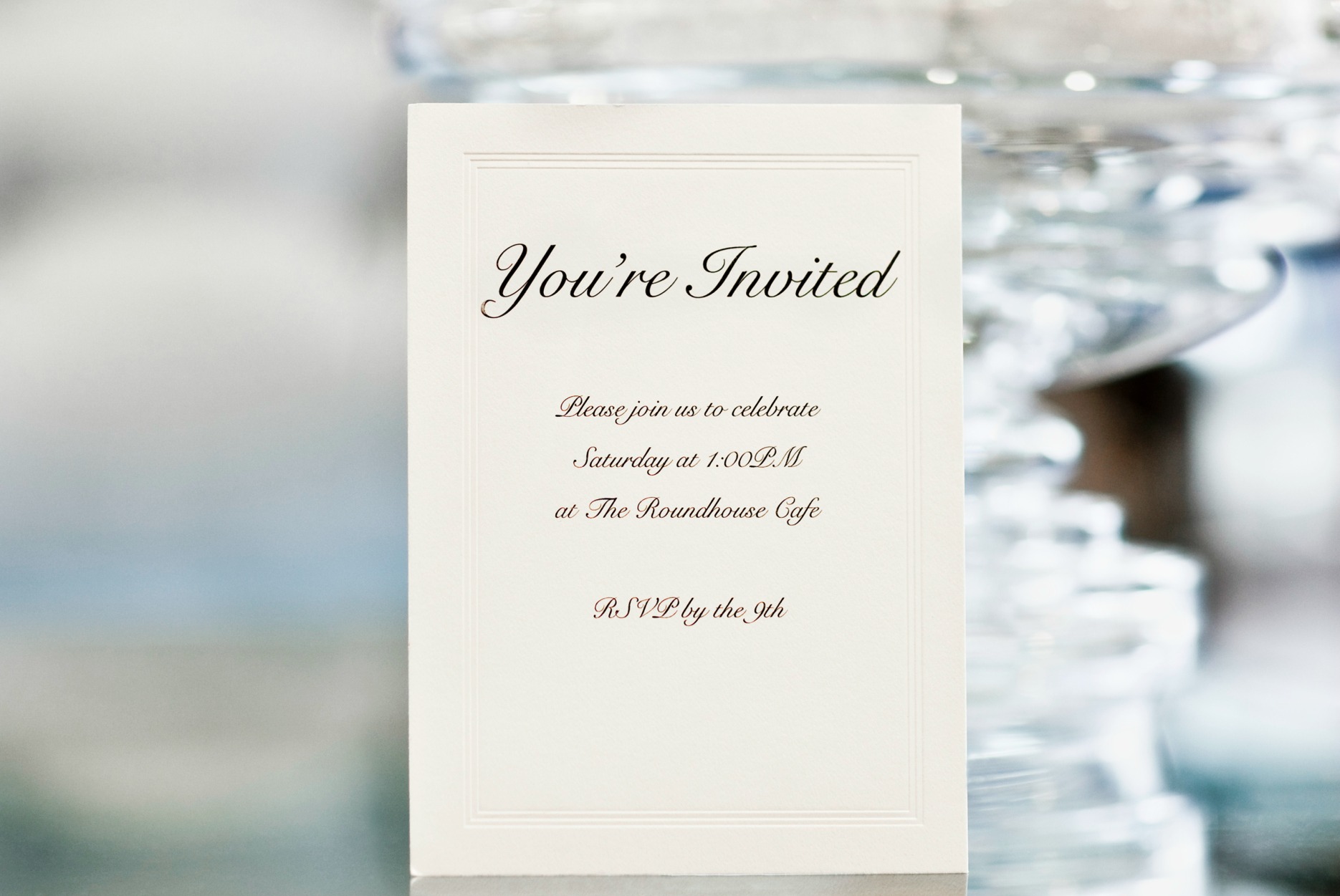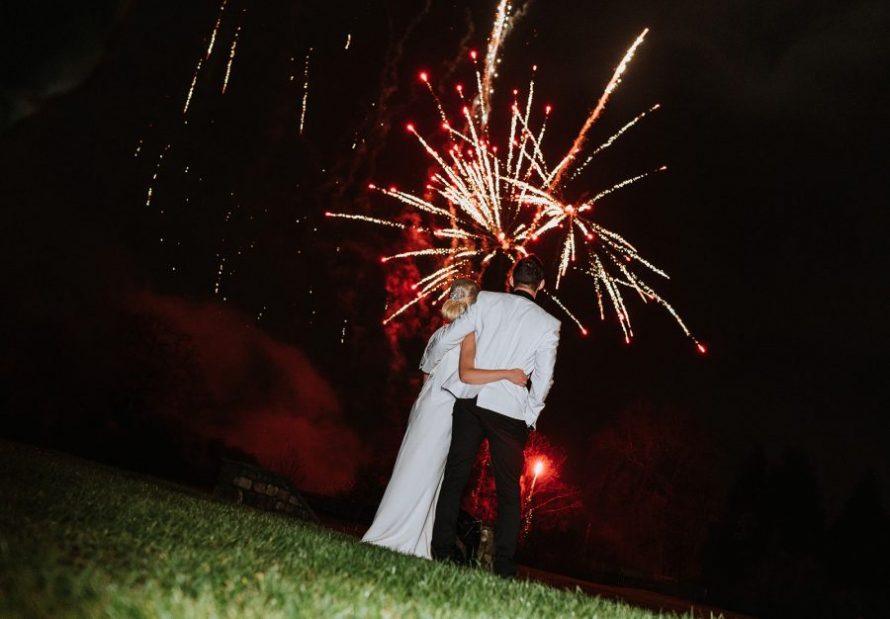Before selecting the wording for your wedding invitations, it is important to consider and clarify what the style of your wedding will be. A wedding invitation sets the tone for the occasion and is sometimes considered a visual prelude to the styling, tone and mood of the wedding itself.
A formal wedding generally requires traditional wording on the wedding invitations, whereas, a less formal affair is better suited to modern wording. Here are some examples of wedding invitation wording to help guide you.
When to send out wedding invitations
Traditionally, wedding invitations should be sent six – 12 weeks prior to the wedding day.
If you are using a wedding invitations business or supplier to produce your invitations they will help guide you as to when you should begin delivering your invitations, however, many modern couples opt to send their wedding invitations out two-months before the wedding day.
If you are making your own invitations or purchasing your invitations online you will need to allow ample time for production and postage, especially if you are ordering from overseas.
What if I want to hand deliver them?
Some people prefer to hand deliver all their wedding invitations, so if you or your future-spouse fall into that category you will need to allow ample time to hand deliver your invitations to the homes of all your guests.
What if I have guests who live overseas?
When you have guests that are travelling from overseas, invitations may go out up to 12 weeks in advance. Bear in mind, however, that if guests living overseas are close family, they will be aware of the date well in advance (as most people are these days!) and receiving the wedding invitation is merely a formality.
[ew-supplier-carousel]
Traditional wedding invitation wording
If you are having a formal, traditional wedding, you may find that traditional wording will be more suitable for your wedding invitations. Using traditional wording will create a cohesive tone for your wedding and will also insinuate to your guests that your wedding will be a formal, rather than casual, affair.
Very traditional
Super traditional wording is based on the notion that the brides’ parents are the hosts and therefore pay for the entire wedding.
If this applies to you, here is an example of an invitation of the most traditional kind (whereby only the bride’s parents, as host, announce the wedding) would appear as follows:
Mr & Mrs Anthony Alexander Smith
cordially invite you to attend the
wedding ceremony
of their daughter
Mary Jane Smith
to
Andrew Scott Cross
Sunday the 2nd of October 2016
Ceremony to commence at 1pm
Church name
Church address
Followed by a formal celebration at 6pm
Reception venue name
Reception venue address
*Note that the parents are addressed by both of the brides’ father’s first, middle and last names.
Modern traditional
These days, however, traditional invitations need not be so implicitly defined. Most frequently, the groom’s parents appear on the invitation, even though they are not ‘hosting’. This is really a gesture of general courtesy, in an attempt to recognise both sets of parents.
On such an occasion, the invitation would appear as follows:
Mr & Mrs Anthony Alexander Smith
cordially invite you to attend the
wedding ceremony
of their daughter
Mary Jane Smith
To
Andrew Scott Cross
son of Mr & Mrs John Reginald Cross
Sunday the 2nd of October 2016
Ceremony to commence at 1pm
Church name or venue name
Church or venue address
Followed by a formal celebration at 6pm
Reception venue name
Reception venue address
Alternately, parents of both the bride and groom may host the wedding, in which case, they are each addressed appropriately. Such an invitation would appear as follows:
Mr & Mrs Anthony Alexander Smith
together with
Mr & Mrs John Reginald Cross
request the honour of your presence to witness the marriage of their children
Mary Jane Smith
and
Andrew Scott Cross
Sunday the 2nd of October 2016
Ceremony to commence at 1pm
Church name or venue name
Church or venue address
Followed by a formal celebration at 6pm
Reception venue name
Reception venue address

If a parent has passed
If a parent or parents of either the bride or groom has passed away, here’s how to incorporate their names into the invitation:
Mr Anthony Alexander Smith
(in honour of the late Mrs Jane Emily Smith)
together with
Mr & Mrs John Reginald Cross
request the honour of your presence to witness the marriage of their children
Mary Jane Smith
and
Andrew Scott Cross
Sunday the 2nd of October 2016
Ceremony to commence at 1pm
Church name or venue name
Church or venue address
Followed by a formal celebration at 6pm
Reception venue name
Reception venue address
Or, perhaps
Mr & Mrs Anthony Alexander Smith
together with
Mr & Mrs John Reginald Cross
request the honour of your presence to witness the marriage of their children
Mary Jane Smith
(in honour of the late Mrs Jane Emily Smith)
and
Andrew Scott Cross
Sunday the 2nd of October 2016
Ceremony to commence at 1pm
Ceremony to commence at 1pm
Church name or venue name
Church or venue address
Followed by a formal celebration at 6pm
Reception venue name
Reception venue address
Including step-parents
If you would like to include step-parents into the mix, traditionally, the same principle of the hosting party being addressed first apples. In the below example Ms. Helen Smith is the new wife of Mr. Anthony Alexander Smith.
Mr & Mrs Anthony Alexander Smith
and
Mr & Mrs John Reginald Cross
cordially invite you to attend the
wedding ceremony of
Mary Jane Smith
(appreciation to Ms. Helen Smith)
to
Andrew Scott Cross
Sunday the 2nd of October 2016
Ceremony to commence at 1pm
Church name or venue name
Church or venue address
Followed by a formal celebration at 6pm
Reception venue name
Reception venue address
Modern wedding invitation wording
Simple approach
Many modern wedding invitation wording variations do not cite the parents at all; especially if the bride and groom are paying for their wedding. In this context, it is the bride and groom that ‘announce’ the wedding.
Many modern couples opt to have their ceremony and reception at one location which means there is less wording needed on the invitation. Current trends are also headed towards mixing capital letters with lowercase, and using different fonts too. Here is an example of a modern and simple approach to wedding invitation wording:
MARY & ANDREW
ARE GETTING MARRIED!
SUNDAY THE SECOND OF OCTOBER 2016
Ceremony/reception name
At 1:00 PM
Ceremony/reception address
Detailed approach
Modern couples sometimes opt to include a dress code on the invitation, if they are not using traditional wording, (as traditional wording usually implies a dress code). Couples may include the RSVP date on the invitation if they wish. (Traditionally, an RSVP card is included with the invitation in an envelope, however, no mention of the RSVP is included on a formal invitation.) Here’s an example of fairly detailed, modern wedding invitation wording:
The pleasure of your company is requested
to celebrate the marriage of
MARY & ANDREW
SUNDAY THE SECOND OF OCTOBER 2016
At 1:00 PM
CEREMONY NAME
Ceremony location
AND FROM 6:00 PM AT RECEPTION VENUE NAME,
Reception venue location
Dress: JACKET & TIE
RSVP 2ND JUNE 2016
WITH ENCLOSED CARD



